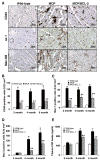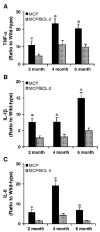Monocyte-specific Bcl-2 expression attenuates inflammation and heart failure in monocyte chemoattractant protein-1 (MCP-1)-induced cardiomyopathy
- PMID: 16643875
- PMCID: PMC1523424
- DOI: 10.1016/j.cardiores.2006.03.008
Monocyte-specific Bcl-2 expression attenuates inflammation and heart failure in monocyte chemoattractant protein-1 (MCP-1)-induced cardiomyopathy
Abstract
Objective: Infiltrating inflammatory cells within the myocardium have been shown to be apoptotic, but the significance of apoptotic inflammatory cells to the development of cardiomyopathy remains undefined. Transgenic mice with cardiac-specific expression of MCP-1 exhibit extensive apoptosis of infiltrating mononuclear cells and develop heart failure. Here, we tested the hypothesis that in vivo selective inhibition of apoptosis of infiltrating mononuclear cells would preserve cardiac structure and function and improve survival in this murine model.
Methods: Mice with cardiac-specific expression of MCP-1 and monocyte-specific expression of Bcl-2 were generated by cross-breeding MCP-1 transgenic mice with hMRP8-Bcl-2 mice that over-express Bcl-2 in the monocytes. Structural and functional parameters and the inflammatory response of the heart were evaluated and compared between the wild-type and transgenic mice.
Results: Expression of Bcl-2 in monocytes results in superior preservation of myocardial structure, cardiac function and a significant prolongation of survival of MCP-1 transgenic mice. The beneficial effects of monocyte-specific Bcl-2 expression are associated with inhibition of apoptosis of infiltrating mononuclear cells, normalization of circulating C-reactive protein levels, attenuation of cellular infiltrates, macrophage activation and production of proinflammatory cytokines, tumor necrosis factor (TNF-alpha), interleukin (IL)-1 beta and IL-6 in the hearts.
Conclusions: These results demonstrate that apoptosis of infiltrating mononuclear cells plays a detrimental role in the development of heart failure in this murine model, suggesting that modulation of apoptosis of infiltrating mononuclear cells may be of clinical benefit in heart failure.
Figures







References
-
- Ikeda U. Inflammation and coronary artery disease. Curr Vasc Pharmacol. 2003;1:65–70. - PubMed
-
- Nian M, Lee P, Khaper N, Liu P. Inflammatory cytokines and postmyocardial infarction remodeling. Circ Res. 2004;94:1543–53. - PubMed
-
- Hansson GK. Inflammation, atherosclerosis, and coronary artery disease. N Engl J Med. 2005;352:1685–95. - PubMed
-
- Dawson J, Miltz W, Mir AK, Wiessner C. Targeting monocyte chemoattractant protein-1 signaling in disease. Expert Opin Ther Targets. 2003;7:35–48. - PubMed
-
- Sheikine Y, Hansson GK. Chemokines and atherosclerosis. Ann Med. 2004;36:98–118. - PubMed
Publication types
MeSH terms
Substances
Grants and funding
LinkOut - more resources
Full Text Sources
Other Literature Sources
Medical
Molecular Biology Databases
Research Materials
Miscellaneous

